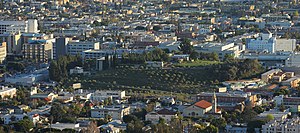
Frank Lloyd Wright Jr., commonly known as Lloyd Wright, was an American architect, active primarily in Los Angeles and Southern California. He was a landscape architect for various Los Angeles projects (1922–1924), provided the shells for the Hollywood Bowl (1926–1928), and produced the Swedenborg Memorial Chapel at Rancho Palos Verdes, California (1946–1971). His name is frequently confused with that of his more famous father, Frank Lloyd Wright.
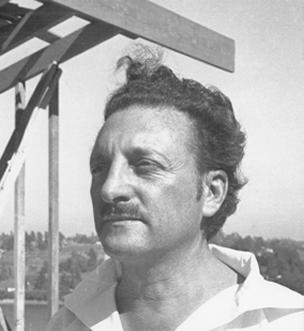
Rudolph Michael Schindler was an Austrian-born American architect whose most important works were built in or near Los Angeles during the early to mid-twentieth century.

Little Armenia is a neighborhood in Central Los Angeles, California. It is named after the Armenians who escaped genocide and made their way to Los Angeles during the early part of the 20th century.

The Ennis House is a residential dwelling in the Los Feliz neighborhood of Los Angeles, California, United States, south of Griffith Park. The home was designed by Frank Lloyd Wright for Charles and Mabel Ennis in 1923 and was built in 1924.
Walter Conrad Arensberg was an American art collector, critic and poet. His father was part owner and president of a crucible steel company. He majored in English and philosophy at Harvard University. With his wife Louise, he collected art and supported artistic endeavors.

The Aline Barnsdall Hollyhock House in the East Hollywood neighborhood of Los Angeles, California, was designed by Frank Lloyd Wright originally as a residence for oil heiress Aline Barnsdall. The building is now the centerpiece of the city's Barnsdall Art Park. In July 2019, along with seven other buildings designed by Wright in the 20th century, it was added to the UNESCO World Heritage List. It is the first time modern American architecture has been recognized on the World Heritage List. The Hollyhock House is noted for developing an influential architectural aesthetic, which combined indoor and outdoor living spaces.

Louise Aline Barnsdall was an American oil heiress, best known as Frank Lloyd Wright's client for the Hollyhock House in Los Angeles, now the centerpiece of the city's Barnsdall Art Park.
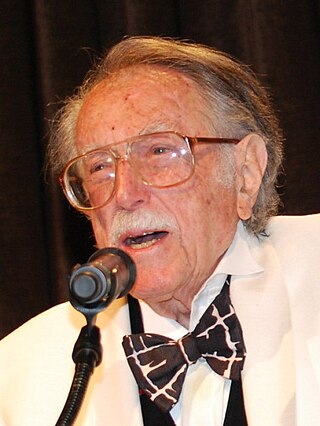
Julius Shulman was an American architectural photographer best known for his photograph "Case Study House #22, Los Angeles, 1960. Pierre Koenig, Architect." The house is also known as the Stahl House. Shulman's photography spread the aesthetic of California's Mid-century modern architecture around the world. Through his many books, exhibits and personal appearances his work ushered in a new appreciation for the movement beginning in the 1990s.
The California Art Club (CAC) is one of the oldest and most active arts organizations in California. Founded in December 1909, it celebrated its centennial in 2009 and into the spring of 2010. The California Art Club originally evolved out of The Painters Club of Los Angeles, a short-lived group that lasted from 1906–09. The new organization was more inclusive, as it accepted women, sculptors and out-of-state artists.
The Social Significance of the Modern Drama is a 1914 treatise by Emma Goldman on political implications of significant playwrights in the late nineteenth and early twentieth centuries.

Judson Studios is a fine arts studio specializing in stained glass located in the Highland Park section of northeast Los Angeles. The stained glass studio was founded in the Mott Alley section of downtown Los Angeles in the mid-1890s by English-born artist William Lees Judson and his three sons. It moved to its current location in 1920 and remains in operation as a family-run business. The Judson Studios building was named a Historic-Cultural Landmark by the City of Los Angeles in 1969 and listed in the National Register of Historic Places in 1999.
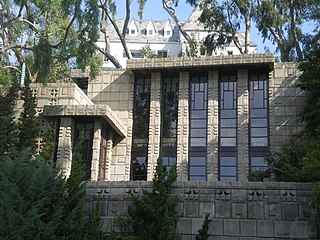
Storer House is a Frank Lloyd Wright house in the Hollywood Hills of Los Angeles built in 1923. The structure is noteworthy as one of the four Mayan Revival style textile-block houses built by Wright in the Los Angeles area from 1922 to 1924.

Cahuenga Branch is the third oldest branch library facility in the Los Angeles Public Library system. Located at 4591 Santa Monica Boulevard in the East Hollywood section of Los Angeles, it was built in 1916 with a grant from Andrew Carnegie. One of three surviving Carnegie libraries in Los Angeles, it has been designated as a Historic-Cultural Monument and listed in the National Register of Historic Places.

Millard House, also known as La Miniatura, is a textile block house designed by Frank Lloyd Wright and built in 1923 in Pasadena, California. It was listed on the National Register of Historic Places in 1976.

The Los Angeles Municipal Art Gallery is located in the Barnsdall Art Park in Los Angeles, California. It focuses on the arts and artists of Southern California. The gallery was first established in 1954.

First Baptist Church of Ventura is a historic church at 101 S. Laurel Street in Ventura, California. It was built in 1926 and renovated extensively into the Mayan Revival style in 1932. Declared a landmark by the City of Ventura In 1975, the building was added to the National Register of Historic Places in 2009. Since 1952, it has been home to the Ventura Center for Spiritual Living.
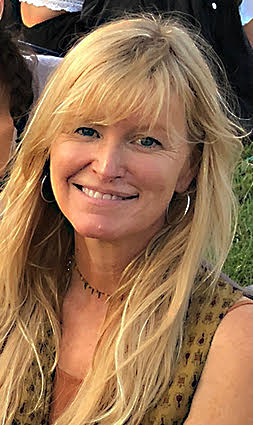
Keri Rosebraugh is an American artist and art administrator. Her artworks often deal with ecological themes and focus on human being’s relationship with nature.
The 20th-Century Architecture of Frank Lloyd Wright is a UNESCO World Heritage Site consisting of a selection of eight buildings across the United States that were designed by American architect Frank Lloyd Wright. These sites demonstrate his philosophy of organic architecture, designing structures that were in harmony with humanity and its environment. Wright's work had an international influence on the development of architecture in the 20th century.
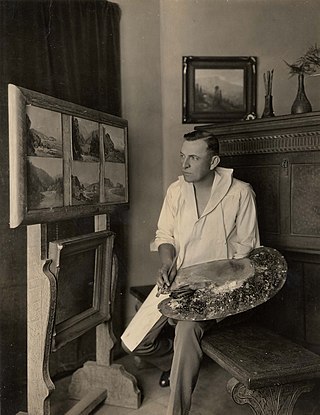
Tilden Daken was an American landscape painter known primarily for his oil paintings of the California redwoods, the Sierra Nevada mountains, and the countryside scenery of Northern California and Southern California. He also painted in Alaska, Mexico, Baja, the Hawaiian Islands, the South Seas, and parts of the East Coast of the United States.
